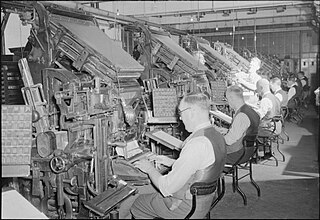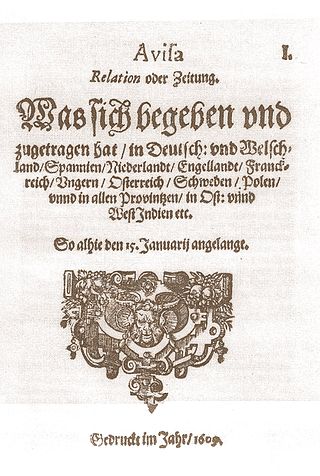
The history of British newspapers begins in the 17th century with the emergence of regular publications covering news and gossip. The relaxation of government censorship in the late 17th century led to a rise in publications, which in turn led to an increase in regulation throughout the 18th century. The Times began publication in 1785 and became the leading newspaper of the early 19th century, before the lifting of taxes on newspapers and technological innovations led to a boom in newspaper publishing in the late 19th century. Mass education and increasing affluence led to new papers such as the Daily Mail emerging at the end of the 19th century, aimed at lower middle-class readers.

The Hartford Courant is the largest daily newspaper in the U.S. state of Connecticut, and is considered to be the oldest continuously published newspaper in the United States. A morning newspaper serving most of the state north of New Haven and east of Waterbury, its headquarters on Broad Street in Hartford, Connecticut is a short walk from the state capitol. It reports regional news with a chain of bureaus in smaller cities and a series of local editions. It also operates CTNow, a free local weekly newspaper and website.

Octavo, a Latin word meaning "in eighth" or "for the eighth time", is a technical term describing the format of a book, which refers to the size of leaves produced from folding a full sheet of paper on which multiple pages of text were printed to form the individual sections of a book. An octavo is a book or pamphlet made up of one or more full sheets on which 16 pages of text were printed, which were then folded three times to produce eight leaves. Each leaf of an octavo book thus represents one eighth the size of the original sheet. Other common book formats are folios and quartos. Octavo is also used as a general description of the size of books that are about 8 to 10 inches tall, and as such does not necessarily indicate the actual printing format of the books, which may even be unknown as is the case for many modern books. These terms are discussed in greater detail in book sizes.
The Barneveldse Krant is a local daily newspaper in the Netherlands. It is printed, published, and distributed by Royal BDU in Barneveld. The newspaper is printed 6 times per week, with a focus on advertisements on Thursday and special weekend pages on Saturday. The Thursday edition is free of charge. It became a daily only in 1967, with 5 issues a week at that time.

The Royal Library of the Netherlands is the national library of the Netherlands, based in The Hague, founded in 1798.

The modern newspaper is a European invention. The oldest direct handwritten news sheets circulated widely in Venice as early as 1566. These weekly news sheets were full of information on wars and politics in Italy and Europe. The first printed newspapers were published weekly in Germany from 1605. Typically, they were censored by the government, especially in France, and reported mostly foreign news and current prices. After the English government relaxed censorship in 1695, newspapers flourished in London and a few other cities including Boston and Philadelphia. By the 1830s, high-speed presses could print thousands of papers cheaply, allowing low daily costs.

Johann Carolus was a German publisher of the first newspaper, called Relation aller Fürnemmen und gedenckwürdigen Historien. The Relation is recognised by the World Association of Newspapers, as well as many authors, as the world's first newspaper.

Avisa Relation oder Zeitung was one of the first news-periodicals in the world. It was published in Wolfenbüttel, Germany, in 1609. The printer/publisher was Lucas Schulte. The first issue states that the news had been collected from various countries by 15 January. It is presumed that the issue was printed on or about that date.
De Nederlandse Courant was a newspaper for Dutch immigrants to Southern Ontario, Canada. Until 2012 it was published by 'The Dutch Canadian Bi-Weekly Inc.' of Burlington, Ontario. After January 2013 it was published by 'The Dutch Newspaper Inc.' of Grimsby, Ontario. It was printed in a tabloid newspaper format. Reduced ad volume and declining readership forced the paper to cut the number of annual issues from 26 to 17 in 2014 and further down to 12 in 2015.

Nathaniel Butter was a London publisher of the early 17th century. As the publisher of the first edition of Shakespeare's King Lear in 1608, he has also been regarded as one of the first publishers of a newspaper in English.
Caspar van Hilten was the editor and publisher of the first Dutch newspaper, the Courante uyt Italien, Duytslandt, &c., printed in Amsterdam from June 14, 1618. He had, in effect, been a press officer for the army of Maurice of Nassau before becoming a publisher. His son Jan van Hilten (c.1603–1655) was born in Hamburg, presumably when Caspar was there as a press officer. Van Hilten was a bookseller as well as a publisher. After his death in 1622 or 1623, the business was continued by Jan, who started to publish the weekly newspaper on a regular day (Saturday). In 1649, Jan van Hilten's bookstore was located on the Beursstraat in a house named (In) de geborduuerde Handtschoen.

Quarto is the format of a book or pamphlet produced from full sheets printed with eight pages of text, four to a side, then folded twice to produce four leaves. The leaves are then trimmed along the folds to produce eight book pages. Each printed page presents as one-fourth size of the full sheet.

A newspaper is a periodical publication containing written information about current events and is often typed in black ink with a white or gray background. Newspapers can cover a wide variety of fields such as politics, business, sports, art, and science. They often include materials such as opinion columns, weather forecasts, reviews of local services, obituaries, birth notices, crosswords, editorial cartoons, comic strips, and advice columns.

Newsbooks were the 17th-century precursors to today's newspapers. Originating in England and Scotland, they are distinct from the earlier news periodicals, known as corantos, which were sourced from continental Europe.
The history of journalism in the United Kingdom includes the gathering and transmitting of news, spans the growth of technology and trade, marked by the advent of specialised techniques for gathering and disseminating information on a regular basis. In the analysis of historians, it involves the steady increase of the scope of news available to us and the speed with which it is transmitted.
Mediahuis Noord, formerly known as NDC Mediagroep, is a Dutch publisher of newspapers, magazines, and websites focused on the three northern provinces of the Netherlands: Drenthe, Friesland and Groningen. It is owned by Mediahuis, a Belgian company. Headquarters are in Leeuwarden, other offices are in Groningen and Meppel. In addition to three main provinces, NDC publishes and distributes also in the Kop van Overijssel, Noordoostpolder, and northern Flevoland.
The Groninger Courant was a Dutch newspaper, published in the City of Groningen under four different titles, between 1743 and 1811. The newspaper contained four pages on one folded sheet.
Folke Dahl (1905–1970) was a Swedish librarian who had a large impact on the study of the early history of newspapers. He was also a pioneering historian of Astrology. His works were published in English.

Hotel Des Indes is a hotel located at the Lange Voorhout in The Hague, The Netherlands. It was constructed as a mansion in 1858. In 1881, it opened as a hotel.












